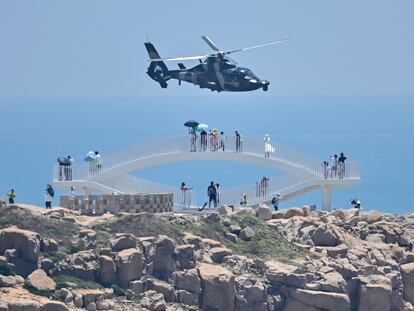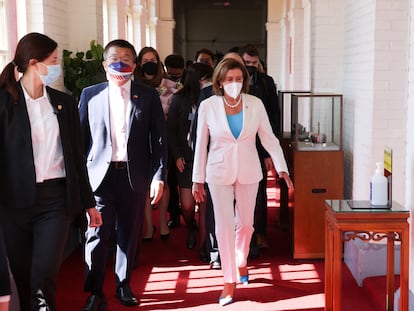Why Nancy Pelosi’s visit to Taiwan scares the world: Keys to the US-China conflict
Beijing reacts to the American politician’s trip with military exercises, but experts see little likelihood of war

Nancy Pelosi’s brief visit to Taiwan has turned up the heat on the long-simmering dispute between China and the island it considers an inalienable part of its homeland. US House Speaker Nancy Pelosi said her visit was intended to make it “unequivocally clear” that the United States would “not abandon” the democratically governed island. This infuriated Chinese leaders who warned the US about “playing with fire” and threatened a forceful response. A dispute that began as World War II ended has flared up in recent years due to President Xi Jinping’s assertiveness in defending Chinese interests and Taiwanese government’s gradual distancing from the giant that looms across the Taiwan Strait.
What are the impacts of Pelosi’s visit to Taiwan?
The Speaker of the US House of Representatives is the highest-ranking US politician to set foot on the island since Newt Gingrich’s 1997 visit, when China was otherwise occupied integrating Hong Kong (annexed by the United Kingdom in 1842 and returned to China in 1997). Gingrich was also US House Speaker at the time, and Democrat Bill Clinton was in the White House. China chose to interpret Gingrich’s Taiwan visit as political jockeying between Republicans and Democrats. But both Pelosi and President Joe Biden are Democrats.
China’s prosperity and wealth has increased tremendously in the past 25 years. As it continues to build up its military, China has demonstrated more impatience with Taiwan, believing that it has no right to maintain independent diplomatic relations. When senior foreign officials visit the “rebel territory,” China interprets it as support for Taiwanese independence.
As rumors of Pelosi’s visit began to swirl a few weeks ago, China warned that it strongly opposed such a visit and would not hesitate to take “strong measures.” On the day Pelosi landed in Taiwan, Beijing announced new military maneuvers around the island lasting several days, including missile launches. The airspace and coastal waters around China’s Fujian province (nearest to Taiwan) were restricted for exclusive military use.
China also banned imports of products from more than 100 Taiwanese companies in the food, agriculture, and fishing sectors. Analysts anticipate an increase in Chinese military exercises in the region, as well as new Chinese sanctions against the island. However, they see little likelihood that escalating tensions will trigger a military conflict.
What is Taiwan’s status?
Taiwan is not a special administrative region of China, like Hong Kong and Macau, but functions as a de facto state with a democratically elected government, a constitution, and a military force of 300,000. Taiwan has the 21st-largest economy in the world, and is a global leader in semiconductors with over 65% of the market share.
China, however, considers the island a “rebel” province with an illegitimate government. Chinese diplomacy is based on the One China principle; that is, there is only one China, and it includes Taiwan.
The Taiwanese issue has been a constant theme in the policies of the Communist Party of China, although the rhetoric has been become more heated since President Xi Jinping was elected. China’s main objective is to defeat any attempt toward Taiwan independence, and it espouses a peaceful “reunification” process, although it never rules out the use of force as a last resort. In Xi’s own words, reunification is part of the “historical mission of the Communist Party of China.”
Has Taiwan historically been part of China?
Taiwan was part of China from 1683-1895, during the Qing dynasty. When China was defeated in the First Sino-Japanese War in 1895, it was forced to cede Taiwan to Japan. China recovered control over the island in 1945 when Japan was defeated in World War II. Civil war raged in China for the next four years until Nationalist troops led by Chiang Kai-shek fled the mainland and took refuge in Taiwan after being defeated by Mao Zedong’s communist forces in 1949. Chiang Kai-shek established the Republic of China (ROC) in Taiwan while Mao Zedong founded the People’s Republic of China (PRC) on the mainland.
Does the international community recognize Taiwan as a sovereign state?
The United Nations ended its recognition of the ROC as a sovereign state in 1971 and instead formally recognized the PRC. Many countries followed suit. Currently, only 13 nations and the Vatican maintain diplomatic ties with Taiwan instead of China.
What is the US position toward Taiwan?
Taiwan is part of what is known as the “first island chain,” a string of major Pacific archipelagos that extend from the East Asian continental mainland coast. They include a number of archipelagos that are traditionally friendly to the United States and are key to the balance of power in the Asia-Pacific region.
The United States has always had an unofficial relationship with the island, and maintains a “strategic ambiguity” formalized in the Taiwan Relations Act enacted in 1979, the year in which the US recognized the People’s Republic of China.
Because of this ambiguity, the Taiwanese issue has become one of the most sensitive issues between the two superpowers. The US is Taiwan’s main arms supplier and, as President Biden has stated on three occasions (although his press team immediately corrected him), the US would be Taiwan’s most powerful ally in the event of a military conflict with China.
How has Taiwan’s relationship with China evolved?
Taiwan undertook significant democratic reforms in the 1990s after 38 years of martial law under the Kuomintang (Chinese Nationalist Party), the longest period of martial law in history (later surpassed by Syria). In 2000, the Democratic Progressive Party (DPP), ascended to power by openly advocating autonomy from China. In 2008, the Kuomintang returned to power and attempted to patch up relations with China through trade and investment agreements.
Tsai Ing-wen of the DPP won the presidency in 2016 and was reelected with an absolute majority in 2020, dealing a severe blow to friendly relations with Beijing. The major fault line in Taiwanese politics is independence or unification with China, although many straddle the fence and favor maintaining the status quo of Taiwan as a de facto state. The Kuomintang officially accepts the One China principle and does not discourage reunification, while the DPP officially considers the Republic of China to be an independent state.
What do the Taiwanese people want?
According to a June 2022 survey, the vast majority want to maintain the status quo indefinitely. Only 5.2% support independence, while 1.3% aspire to reunification with China. More than 60% of the population identifies itself as Taiwanese citizens, while just over 30% identifies itself as being of Chinese-Taiwanese nationality.
Tu suscripción se está usando en otro dispositivo
¿Quieres añadir otro usuario a tu suscripción?
Si continúas leyendo en este dispositivo, no se podrá leer en el otro.
FlechaTu suscripción se está usando en otro dispositivo y solo puedes acceder a EL PAÍS desde un dispositivo a la vez.
Si quieres compartir tu cuenta, cambia tu suscripción a la modalidad Premium, así podrás añadir otro usuario. Cada uno accederá con su propia cuenta de email, lo que os permitirá personalizar vuestra experiencia en EL PAÍS.
¿Tienes una suscripción de empresa? Accede aquí para contratar más cuentas.
En el caso de no saber quién está usando tu cuenta, te recomendamos cambiar tu contraseña aquí.
Si decides continuar compartiendo tu cuenta, este mensaje se mostrará en tu dispositivo y en el de la otra persona que está usando tu cuenta de forma indefinida, afectando a tu experiencia de lectura. Puedes consultar aquí los términos y condiciones de la suscripción digital.
More information

China sends 100 war planes to military drills near Taiwan, sanctions Pelosi
Últimas noticias
Welcome to the post-religion era: The idea of Christianity as the absolute truth has become obsolete
‘I thought you would like it’: The risky sexual practice popularized by TV shows and TikTok
The digitalization of tourism: ‘They promise experiences and gave us the worst possible one’
Mexican peso defies uncertainty with forecasts of a new period of stability in 2026
Most viewed
- Sinaloa Cartel war is taking its toll on Los Chapitos
- Oona Chaplin: ‘I told James Cameron that I was living in a treehouse and starting a permaculture project with a friend’
- Reinhard Genzel, Nobel laureate in physics: ‘One-minute videos will never give you the truth’
- Why the price of coffee has skyrocketed: from Brazilian plantations to specialty coffee houses
- Silver prices are going crazy: This is what’s fueling the rally










































